Executive Summary
Firearm violence is a significant concern for many sexual and gender minorities in the United States. For example, guns were used in nearly 60% of bias-motivated homicides of LGBT people tracked by the National Coalition of Anti-Violence Projects in 2017. In addition to their role in intentional killings by others, firearms are widely used in suicides in the United States; firearms are also used to intimidate and threaten, and they can cause unintentional deaths and injuries. Gun violence in the LGBT population is thus of significant concern given substantial research finding that, compared to non-LGBT people, LGBT people have a higher prevalence of suicide ideation and attempts, comparable or higher prevalence of intimate partner violence, and higher lifetime prevalence of victimization from hate crimes, school-based violence, and discrimination.
Yet, research specifically addressing gun violence against or by sexual and gender minorities is rare. This in part reflects the fact that gun violence across the U.S. population is generally understudied, but studying gun violence against sexual and gender minorities is particularly challenging because of a lack of data. Researchers have developed best practices for measuring sexual orientation and gender identity in population-based surveys and other data systems (e.g., GenIUSS Group 2014; SMART 2009), but the death and injury surveillance systems in the United States typically do not measure victims’ or perpetrators’ sexual orientations, gender identities, or gender expressions. By “sexual minorities,” we mean people who are not, or not completely, heterosexual in their sexual identity, attraction, or behavior—including but not limited to lesbian, gay, or bisexual identified people. By “gender minorities,” we mean people whose gender identity or expression does not conform to traditional, binarized, and fixed understandings of sex and gender—including but not limited to people who identify as transgender or non-binary.
Without research and data specific to sexual and gender minorities, we cannot fully know how and to what extent gun violence in all its forms impacts this population. We also do not know what role geography, race/ethnicity, age, gender, economic status, veteran status, disability, language, immigration status, and other characteristics play in gun violence affecting this population. For example, research consistently finds the highest prevalence of firearm suicide among non-Hispanic White men and the highest prevalence of firearm homicide among non-Hispanic Black men. But do these and other racial patterns hold among sexual and gender minorities? And do known risk factors for firearm suicide death and homicide—including gun ownership, alcohol abuse, and joblessness—similarly or differently apply to sexual and gender minorities?
The lack of research and data similarly hinders our ability to evaluate whether general prevention efforts, such as laws restricting who can have guns and when, are effective with respect to sexual and gender minorities, as well as to assess the need for, and design of, evidence-based interventions that target this population or any number of subgroups (e.g., transgender women of color, those in rural locations, bisexual women in relationships with men, or veterans). Researchers have noted the need for LGBT-specific or LGBT-competent interventions, such as health services that attend to the unique concerns of LGBT people and culturally-competent law enforcement responses to violent situations involving LGBT people.
This report collects and synthesizes the literature on gun violence impacting both the general population and sexual and gender minorities (particularly LGBT people) in the United States, in order to provide a baseline understanding, establish a research agenda, strengthen the call for expanded and improved data collection and research, and inform prevention efforts. Specifically, we address suicide death, attempt, and ideation; intimate partner violence (including homicide); and community violence such as hate crimes, homicides, school violence, and mass shootings. We also discuss evidence-based strategies to prevent firearm injuries and death and highlight major research and data gaps. We approach these topics from a public health perspective, which involves trying to understand and address the root causes of gun violence.
In a separate study (Conron et al. 2018), we analyzed data from the General Social Survey, a U.S. representative sample, to provide the first-ever estimates of the prevalence of guns in the homes of LGB people compared to non-LGB people in the United States. LGB adults were significantly less likely than heterosexual adults to report having at least one gun in their home (18.8% and 35.1%, respectively). Among heterosexual and LGB adults, non-Hispanic Whites were most likely to have a gun at home. And although heterosexual men were most likely to report having a gun, gun ownership was similar for LGB men and women.
Additionally, the study analyzed data from the Cooperative Congressional Election Survey, also a U.S. representative sample, and found that LGB adults were slightly more likely than heterosexual adults to favor policies that restrict access to guns, such as background checks. Because the presence of guns in the home is associated with lethal violence, our findings suggest that LGB adults may be at lower risk for suicide deaths and intimate partner homicides by firearm. We note, however, that many LGBT youths live in the homes of heterosexual adults who are more likely to have guns than LGB adults. In addition, LGBT people, like others, might be able to access a firearm without having access to one at home or owning one.
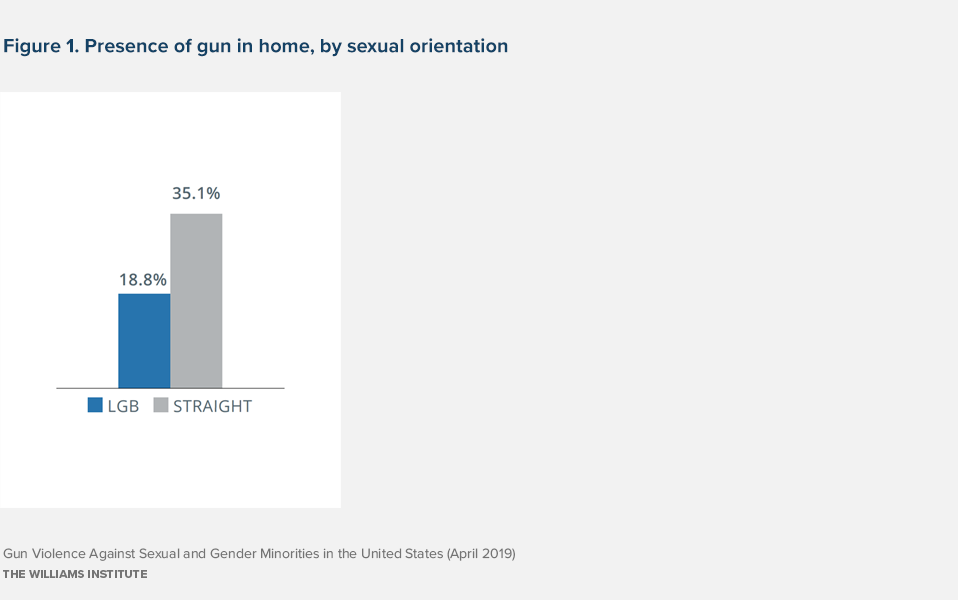
There are many unknowns documented in this report that merit future investigation. For example, why LGB adults are less likely to have a gun at home and are more likely to support certain legal restrictions is unknown. Also unknown are statistics regarding transgender people, such as their prevalence of gun ownership and attitudes toward gun policies. Richer data and more research using a variety of methods could help address a range of questions that would enable us to gain a more specific, and nuanced understanding, which would enhance prevention efforts.
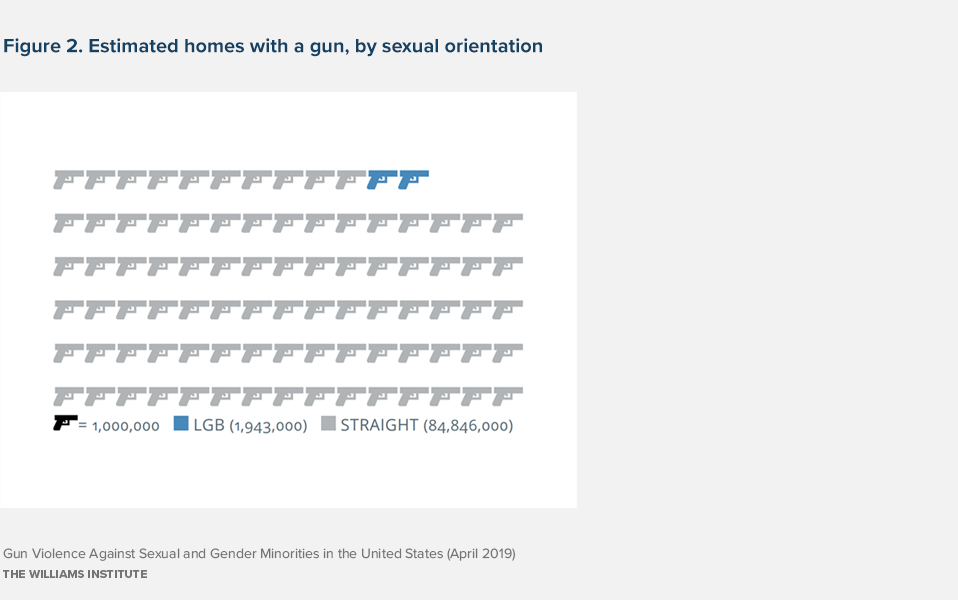
Unfortunately, we identified scant research addressing potential variability in gun violence risk for sexual and gender minorities by gender, race, geography, age, socio-economic status, and veteran status. These are some of the important, intersecting lines of inquiry with respect to gun violence generally (e.g., Crenshaw, 1990; Knopov 2018; McCall, Land, & Parker 2010; Pinchevsky & Wright 2012; Riddell et al. 2018; Rowhani-Rahbar et al. 2019), and we expect they will be as well with respect to sexual and gender minorities. Nor is there sufficient research on how and to what extent known risk factors for, and protective factors against, gun violence in the general population apply to sexual and gender minorities, and whether there are LGBT-specific risk and protective factors.
Theories of population distribution, such as social-ecological models (see generally Krieger 2001), that can be used to understand health disparities could be used to inform future research on sexual orientation and gender identity variations in gun violence. Likewise, more research is needed to explore gun violence with respect to minority stress and the cumulative advantage/disadvantage hypothesis (see generally Cochran & Mays 2017; Meyer & Frost 2013; Meyer 2003).
Suicide Death, Attempt, and Ideation
According to the Centers for Disease Control and Prevention (CDC), suicide is the tenth leading cause of death in the United States. Suicide deaths are especially prevalent among males and, according to some studies, veterans. Suicide is the second leading cause of death among youth and young adults (ages 15-24). More than half (51%) of suicides are by firearm. Suicides by firearm, in turn, account for three-fifths of firearm deaths in the United States, reflecting more than twice the proportion of firearm homicides. Indeed, a suicide attempt by firearm is usually lethal, resulting in death 85% of the time (Miller, Azrael, & Barber 2012). More generally, substantial research documents the relationship between the presence of firearms in the home and the increased risk of suicide by firearm. The majority of firearm suicides are concentrated among non-Hispanic White males and those living in rural areas, and mortality rates generally increase with age. Gun use is also common in cases of suicide among veterans.
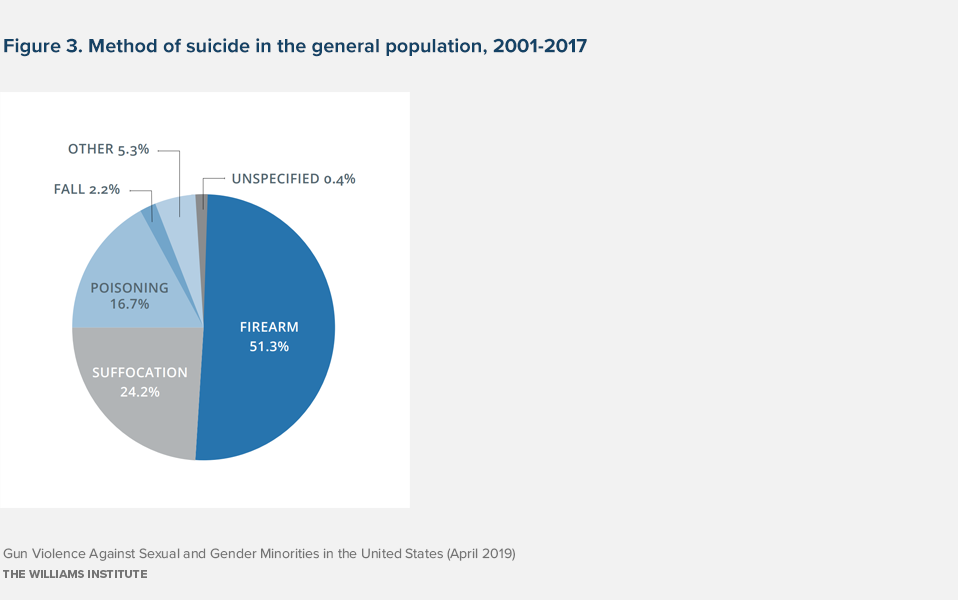
LGBT people have a higher prevalence of suicide attempts and ideation than their non-LGBT peers, which is connected to stigma and prejudice against minority sexual orientations and gender identities. For example, according to the CDC’s Youth Risk Behavior Survey in 2017, 47.7% of gay, lesbian, or bisexual students and 31.8% of “not sure” students, as compared to 13.3% of heterosexual students, had seriously considered suicide in the 12 months before the survey (Kann et al. 2018).
Suicide attempts are highly prevalent among transgender youth, with one recent study finding 34.6% of transgender youth had attempted suicide in the past year, compared to 9.1% of cisgender girls and 5.5% of cisgender boys (Johns et al. 2019). Some research indicates that LGB veterans’ suicide attempts and ideation is similar to or higher than straight veterans (Blosnich, Mays, & Cochran 2014; Blosnich, Bossarte, & Silenzio 2012). And Blosnich, Bossarte, and Silenzio (2013) found that same-sex-partnered veterans had twice the odds of keeping firearms in the home than sexual minorities who are not veterans.
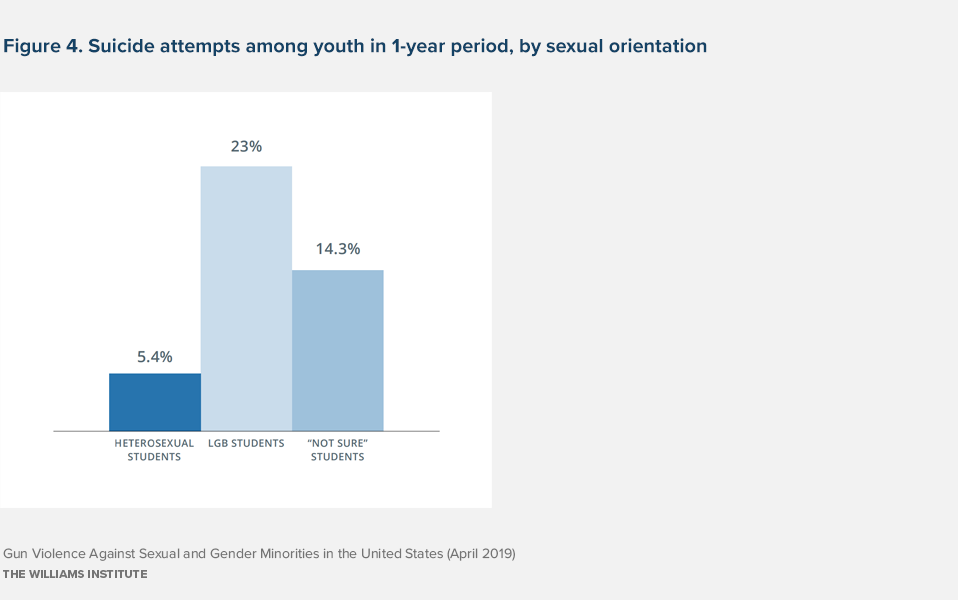
Data Source: Kann et al. 2018
However, very little data exists on suicide deaths among LGBT adults and youth, including data that would permit analyses by race/ethnicity, geography, age, gender, veteran status, etc. Nor has research systematically investigated methods of suicide among LGBT people or the role of guns in suicide attempts and ideation among LGBT people. One major reason for this lack of information is that individuals’ sexual orientation and gender identity are not collected in death records and are infrequently collected in national and state surveillance systems that track suicidal behavior. One recent study of suicide deaths from 18 states found that 0.5% of suicide decedents were LGBT, the majority of whom were gay men (Lyons et al. 2018). Importantly, however, the authors cautioned that their findings likely underestimate LGBT suicide deaths given the incompleteness of the data and the challenges of identifying LGBT statistics postmortem, including having to rely on third-party informants rather than individuals’ self-identification. In this study, a firearm was the second most common means of suicide for gay men, lesbians, and bisexuals, and the third most common means for transgender persons. Gay men and lesbians were both more likely to experience mental health issues, a history of suicidal thoughts or plans, and intimate partner problems than non-gay males and non-lesbians, respectively; given the small number of decedents who identified as bisexual or transgender, they were not included in this secondary analysis. Another recent study found that LGBT youth and young adults are disproportionately represented among suicide decedents and that bisexual males had the highest prevalence of firearm suicide among the sample (Ream 2019). However, this study was prone to the same limitations of the incompleteness of data about sexual orientation and gender identity. Further, Cochran and Mays found that women who have sex with women have a greater risk for suicide than women with male partners only, but these differences were not observed between men who have sex with men and men with female partners only (Cochran & Mays 2015, 2011).
Intimate Partner Violence
Violence among intimate partners is widespread in the United States. According to the CDC, over 10 million people in the United States experience physical violence each year by a current or former intimate partner. Both women and men experience intimate partner violence (IPV), though the majority of victims are female (Breiding et al. 2015). Many victims experience IPV at a young age (Breiding et al. 2015). According to the CDC, multi-racial, non-Hispanic Black, and American Indian/Alaskan Native women and men have the highest prevalence of IPV. Such violence can lead to death (intimate partner homicide or IPH), injury, and other negative mental and physical health outcomes (especially for victims). Firearms play a substantial role in IPH (Fridel & Fox 2019), and many IPV victims report being threatened and coerced with firearms (The National Domestic Violence Hotline 2014).
Research on IPV among LGBT people is limited but finds that they experience IPV at a prevalence equal to or higher than the general U.S. population. Bisexual women, in particular, report high levels of IPV at the hands of male partners (Walters, Chen, & Breiding 2013). Data on transgender IPV survivors and perpetrators are limited to non-representative samples but indicate levels of IPV that are similar to or higher than the general population. Correlates of IPV for same-sex couples are consistent with those of heterosexual couples, such as psychological distress and substance abuse. Likewise, factors such as childhood adversity, including exposure to violence and physical and sexual abuse, increase the risk of IPV perpetration for both heterosexual (Roberts et al. 2011) and same-sex couples (Welles et al. 2011). Research further finds that sexual minorities may face unique risk factors for IPV related to their sexual minority status (such as feeling negatively about their LGB identity). Research on unique vulnerabilities and assets/resources of transgender people is needed. Research on intimate partner homicides among LGBT people is challenging given the dearth of sexual orientation and gender identity data on death records. Nevertheless, studies of IPH among same-sex partners find that men are more likely to be victims of IPH than women. IPV research focused on LGBT subpopulations, such as racial minorities, is rare and needed.
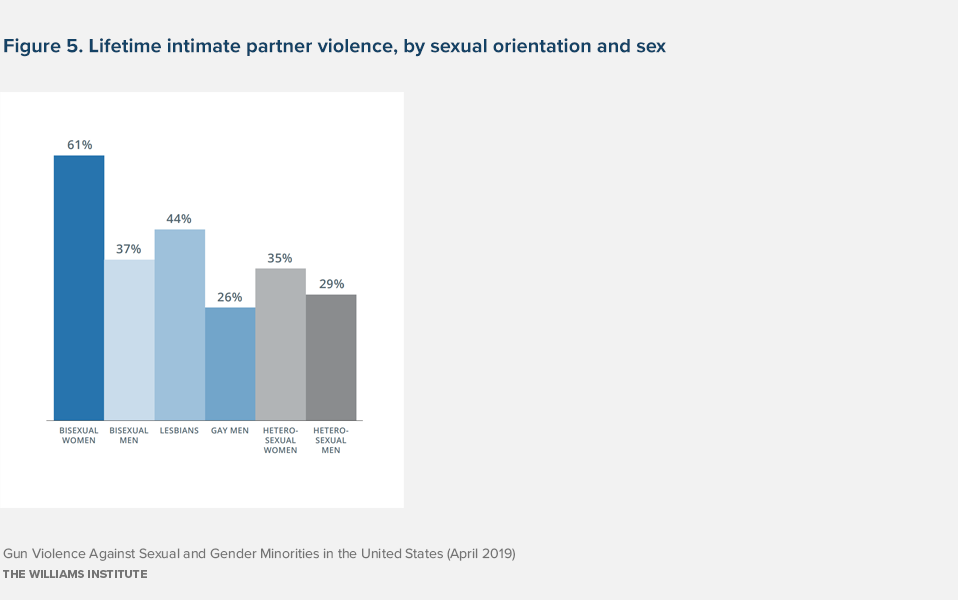
Data Source: Walters, Chen, and Breiding 2013
Generally, when perpetrators of IPV have access to firearms, the risk of homicide increases. While firearm IPH in the general population was long on the decline, since 2010, there has been a 26% increase (Fridel & Fox 2019). Limited research indicates that the prevalence of gun use against gay and lesbian victims of IPH may not be as high as with heterosexual victims, which could possibly reflect the lower prevalence of guns in the homes of LGB people compared to non-LGB people found by Conron et al. (2018). Scant information exists about when and how firearms are used in non-fatal IPV against LGBT victims. Bisexual women, though, may be particularly at risk for firearm IPV and IPH given the high prevalence of IPV by male partners.
For example, according to the National Intimate Partner and Sexual Violence Survey, 15% of bisexual women compared to 4.4% of heterosexual women reported that their partner used a knife or a gun (Walters, Chen, & Breiding 2013).

Data Source: Walters, Chen, and Breiding, 2013
Community Violence
On average, over 10,300 hate crimes involve a firearm each year (Everytown for Gun Safety 2018c). Nearly a fifth of hate crimes are based on sexual orientation or gender identity bias, according to the Federal Bureau of Investigation’s Uniform Crime Reports (UCR). Thus, although the majority of hate crimes are based on race/ethnicity/ancestry bias, LGBT people, per capita, are more likely to be targeted for a hate crime than any other group (Park & Mykhyalyshyn 2016). Importantly, the UCR underreports incidents of hate violence because it includes only hate crimes that survivors have reported to the police and that the police have confirmed and voluntarily reported to the FBI. But many survivors do not report violent incidents to law enforcement, and the police do not report all hate crimes as such. What’s more, many hate crime victims are often targeted for multiple, intersecting identities that may not be captured in hate crime reporting. Examining incidents classified as single-bias crimes, researchers have found that victims of sexual orientation-bias crimes are subject to person-based (rather than property-based) violence at higher rates than victims of religiously- or racially-motivated crimes (Rubenstein 2003). Further, research indicates that gay men are the most frequent victims of anti-LGBT hate crimes; transgender people, especially transgender women of color, may be particularly vulnerable to bias homicide. Additionally, studies show that LGBT youth are subjected to a higher prevalence of school-based violence than non-LGBT youth (Johns et al. 2019; Kann et al. 2018).
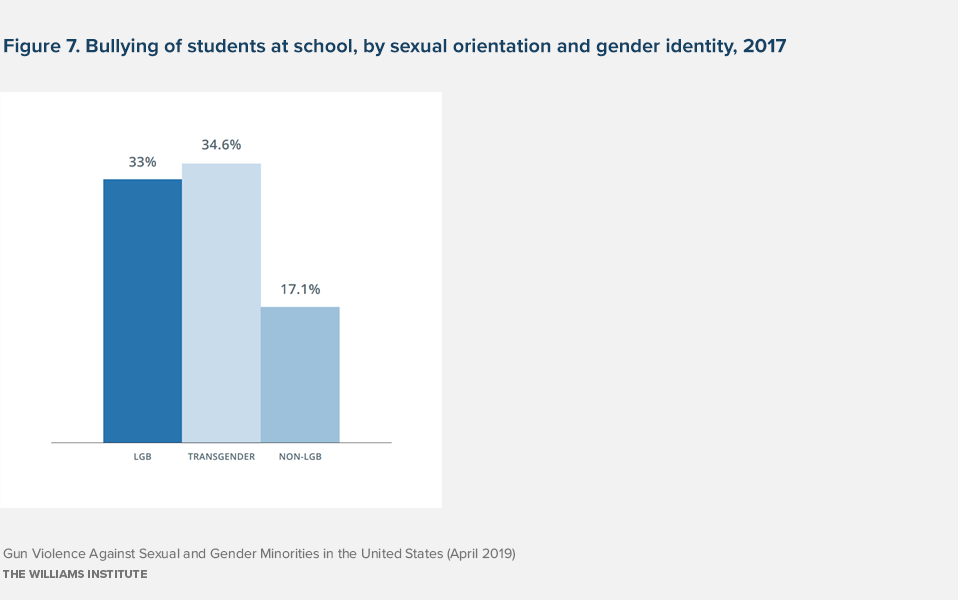
Data Source: Kann et al. 2018 & Johns et al. 2019
Some data indicate that hate crimes and school violence against LGBT people may be more likely to involve weapons and physical injury, compared to such violence against non-LGBT people. However, existing research provides limited information on the prevalence of firearms in these and other forms of community violence involving LGBT people. For example, according to UCR data, a higher percentage of anti-LGBT hate crimes are reported as aggravated assaults than other bias crimes; however, the UCR does not disaggregate the type of weapon used (if any) in aggravated assaults. What’s more, even with data on aggravated assaults, research is needed to discern if there is a statistically significant difference in the prevalence of aggravated assaults across sexual orientation and gender identity bias-motivated crimes. Similarly, data on school violence indicates that sexual and gender minority students are more likely to be threatened with a weapon, without disaggregating weapon type (Johns et al. 2019). Some research also finds that lesbian, gay, bisexual, and queer students are more likely to bring weapons with them to school (possibly to protect themselves from violence by other students) (Button & Worthen 2017), though another study suggests LGB students are less likely to carry a gun (not specifically limited to school property) (Kann et al. 2018). We were unable to find research on the extent to which LGBT people use firearms in these contexts or act as perpetrators of community violence more broadly.
Even less is known from a research perspective about law enforcement shootings of LGBT people, as well as the role of firearms in street violence and non-IPV sexual violence against LGBT people. Lastly, while some serial killings and mass shootings (outside the context of schools or workplaces) have involved guns to victimize LGBT people, these forms of community violence are rare.
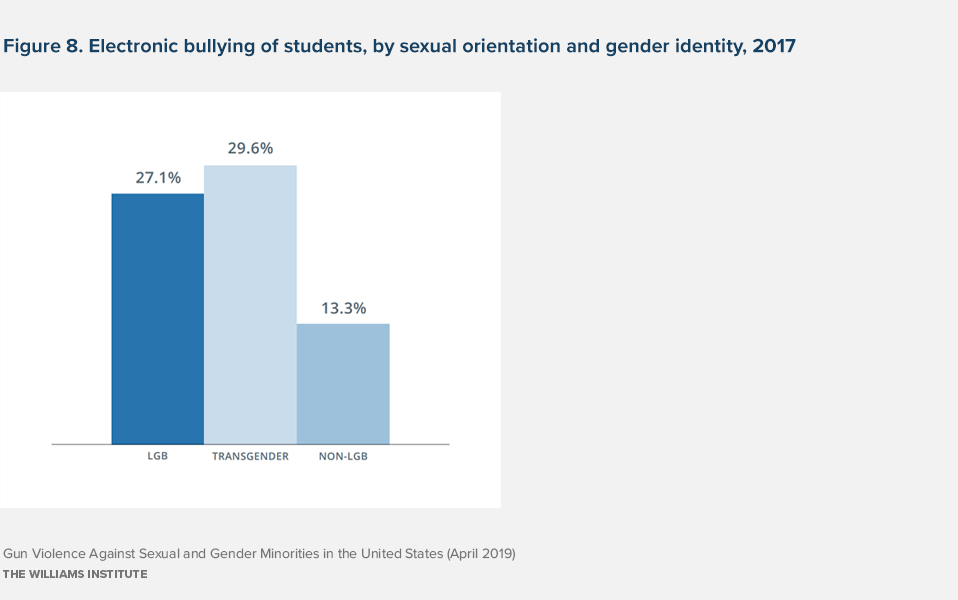
Data Source: Kann et al. 2018 & Johns et al. 2019
Interventions
In each of the three main parts of this report—suicide, IPV, and community violence—we describe evidence-based and promising violence prevention strategies with a particular focus on gun violence. Given the dearth of research on interventions to prevent gun violence specifically among sexual and gender minorities, we focus on strategies for reducing these forms of violence in the general population, as well as LGBT-focused strategies to reduce violence generally (which may or may not involve guns). Much more research is needed to evaluate the effectiveness of general gun violence prevention strategies as to LGBT people and sexual and gender minorities more broadly, and whether there are interventions that would particularly benefit them. And, more research is needed on the effectiveness of gun violence prevention laws, policies, and other interventions generally (e.g., Irving 2018). Among the interventions we discuss are:
Law and Policy
- Safety protocols around access to firearms, such as criminal background checks for all firearm purchases, waiting periods, minimum age requirements, permit to purchase (PTP) laws, and enhanced storage
- Restrictions related to Extreme Risk Protective Orders or Domestic Violence Restraining Orders
- Court-ordered conflict management counseling for intimate partner or domestic violence perpetrators
- Economic and other supports (such as household finances and stable housing) to buffer against risk factors for violence and to improve protective factors
Prevention Services
- Mental health services
- Healthcare providers (such as primary care physicians) who are trained in identifying and responding to correlates of violence, and who could offer an effective point of intervention
- Healthcare providers trained to ask about firearms, especially with patients with high risk for suicide
- LGBT-competent and LGBT-specific mental health, anti-violence, substance use, and other services
- Reduction of barriers to LGBT people accessing existing anti-violence services and programs
Community Interventions
- Promotion of coping, problem-solving, and conflict resolution skills
- Promotion of safe and healthy relationship skills
- Promotion of social norms that proscribe the use of violence
- Increased trust between law enforcement and LGBT people, especially racial/ethnic minorities
- Reduced anti-LGBT stigma and discrimination in society, in families, at work, at school, and elsewhere
Policy and advocacy groups also promote a number of specific interventions to reduce gun violence for which we have not identified a rigorous evidence base, but which may indeed be effective. These include education of risk of gun suicide and warning signs of suicide through educational materials at gun ranges and gun shops; adding or enhancing lethal means counseling to firearm instructor training; federal and state laws that prohibit someone from buying or having a gun if they have a violent or threatening hate crime misdemeanor conviction; laws that require notification of state or local law enforcement when a domestic abuser or convicted stalker attempts to buy a gun and fails a background check; and closing the so-called “Charleston loophole” in federal law that allows gun sales to proceed by default after three business days, even if background check operators have not confirmed that the buyer is legally allowed to have guns.
Research and Data Needs
Throughout this report, we detail research and data needs that would improve knowledge about gun violence against sexual and gender minorities, laying the foundation to develop prevention and intervention strategies. These include:
Enhanced Data Collection
- Death and injury surveillance on sexual and gender minorities in local, state, and national databases including the National Violent Death Reporting System, and enhanced data collection in the FBI Universal Crime Reporting Program, National Intimate Partner and Sexual Violence Survey, and National Crime Victimization Survey
- Death and injury surveillance data disaggregated by type of weapon
- Population-level information about the extent to which guns are used by or against sexual and gender minorities in events of suicide death, suicide attempt, IPV, and community violence, and such information by geography, race/ethnicity, gender, age, socio-economic status, veteran status, and other characteristics
Research
- Enhanced quantitative and qualitative research on gun ownership and use in the general population and, specifically, sexual and gender minority gun ownership and use
- Enhanced data and research on gun violence impacting sexual and gender minority subgroups, especially population-level information on LGBT suicide deaths, transgender youth suicidality, transgender persons’ access to guns, IPV among transgender and bisexual persons, and bias crimes against LGBT people
- Quantitative and qualitative studies aimed at better understanding the gender, racial, geographic, socio-economic, age, veteran status, and other dimensions of gun-related injury and mortality among sexual and gender minorities across all forms of gun violence
- Research on perpetrators of firearm violence, including on perpetrators of such violence against sexual and gender minorities
- Research on the role of risk factors for, and protective factors against, suicide death, suicide attempt, IPV, and other forms of violence involving firearms
- Researchers of diverse backgrounds and lived experience, and community-participatory research
Interventions
- Research on interventions targeting social determinants of firearm-related deaths, including suicide
- Research on interventions to reduce risk factors for, and enhance protective factors against, firearm violence and violence generally, including on the role of gender in IPV among LGBT people
- Enhanced evaluation of prevention strategies for all forms of gun violence, including firearm safety, messaging, counseling, school-based programs, and trauma-informed approaches
- Evaluations of general prevention strategies applied to sexual and gender minority populations
- Evaluations of the impact of hate crime and anti-discrimination laws on reducing anti-LGBT violence
- Enhanced evaluation of law enforcement training related to responding to, and reporting on, violence situations involving LGBT people
Download the full report







